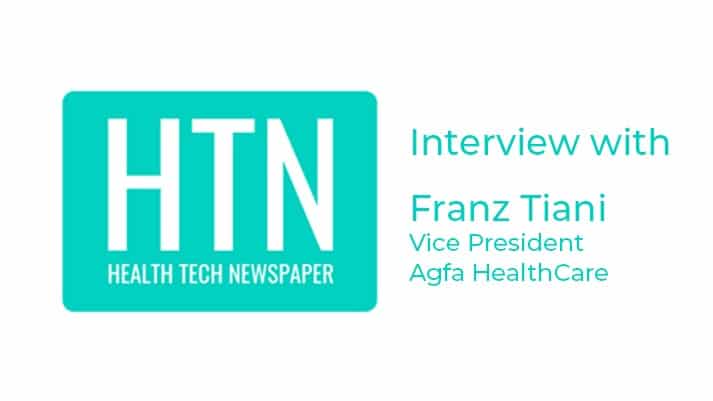For its September Imaging feature, Health Tech News sat together with with Franz Tiani, Vice President of Agfa HealthCare, to hear about some of Agfa’s projects that are currently running, what’s coming up over the next 12 months, as well as sharing some of the main challenges that he and Agfa have faced.
About lighthouse projects, too many IT solutions and why people and teamwork really make a difference. An extract from the article.
To access the full article, click here.
Can you tell me about your customer projects that you’ve been involved in at the moment in the UK market?
Two recent projects spring to mind. The first is with the Yorkshire Imaging Collaboration (YIC), a long-term Agfa customer. The YIC is a combined technology and business transformation project involving eight trusts across Yorkshire, as well as the recently established NHS Nightingale Hospital Yorkshire and the Humber. We have been working with them to roll out our XERO Exchange Network (XEN), which is essentially a piece of technology which allows imaging to be viewed from anywhere across the region. Historically clinicians used large workstations to be able to read an image, but you can now have it so that images can be viewed securely via browser technology and even available on iPads. This is definitely one of the projects I’m extremely proud of, particularly given the benefits it has unlocked during the pandemic.
Another project is at the Princess Alexandra Hospital NHS Trust (PAH), who have been using our Enterprise Imaging platform since 2018. They are really maximising its potential and the trust made significant steps in improving efficiency, by cutting down the time it takes to report images and, thus, waiting times for patients.
After a patient has had a referral, they typically need imaging, such as X-ray — which is not usually a big problem in the NHS; the current infrastructure in most hospitals is sufficient to deal with this. The problem, however, is how fast they can get the images reported; once the imaging is completed, someone needs to look at it and potentially diagnose/report. This process in the UK has always been quite time consuming, but by introducing a technology that allows stakeholders to share this information, image analysis can be completed much quicker, allowing the clinician to be more efficient. This has helped PAH keep up with the workload, unlike many hospitals which are operating with relatively large imaging backlogs.
Princess Alexandra from a technological standpoint, is using most of the pieces of the Enterprise Imaging technology — voice recognition, 3D analysis and soon, artificial intelligence. It’s a lighthouse project.
From the work that you’ve mentioned there, what are/were the biggest challenges and what advice would you give to those on a similar path?
You can have the best technology but, in reality, it’s about people, collaboration and team work. This is why we take a partnership approach with our customer projects. Good leadership is also required, with good management, to get all the stakeholders involved in the IT projects aligned. If that works, you’re halfway there, and the rest will fall into place.
Over the last six months there have been some fantastic examples of how technology can be delivered, often remotely, to help and support the NHS, both now and in the future. We have also seen the NHS taking a pragmatic approach to IT projects. We are all living and working in challenging times, but we are proud to have been part of a positive consequence that resulted in a significant improvement to the way clinicians collaborate and care for patients.
What’s coming up in digital imaging for Agfa over the next 12 months?
Agfa HealthCare’s focus is medical imaging IT; and continually enhancing our platform to maximise technological advances. It is very important for us to keep up with the needs of our customers, to continue our programme of implementations and to support our customers as partners. There have also been quite a few tender wins that we will be announcing over the coming months.
I agree with NHS CEOs when they say “we have too many IT solutions”; we see a number of examples where trusts have well over a hundred different software solutions across their healthcare organisation. That’s a lot to manage, keep up-to-date and integrate. So, for us, one of the most important things is to continue with a go-live schedule of Enterprise Imaging implementations, so that our customers have a modern robust imaging platform that can manage all their imaging data and image-enable their Electronic Patient Records (EPRs).
We are also looking into our technology, and analysing areas that can be improved further. For example, when Microsoft Teams was rolled out across the NHS, we acted quickly to integrate our image viewer with the platform so that staff could easily, quickly and securely communicate. The integration allows for a more complete view of the patient, and it saves a lot of time.
We are also working with a couple of trusts on a range of exciting digital programmes, such as artificial intelligence (AI) in imaging. The progression in AI will have a huge impact on radiology – one aspect is the way in which it will help staff to prioritise work in the right way, finding critical cases automatically. Another aspect is deep learning image analysis, where the technology can help the user do two things: find critical issues in an image and highlight it to the clinician to seek a second opinion.
What will stay at the top of the agenda is ‘sharing’, which will further be improved through increased collaboration between trusts. If you want to be efficient in medicine, you need to provide the data to the right specialist, and data sharing is vital to helping this.

